U.S. Dept. of Commerce / NOAA / OAR / PMEL
/ Publications
Interior pycnocline flow from the Subtropical to the Equatorial
Pacific Ocean
Gregory C. Johnson and Michael J. McPhaden
NOAA, Pacific Marine Environmental Laboratory, 7600 Sand Point
Way NE, Seattle, Washington 98115-6349
Journal of Physical Oceanography, 29, 3073–3089, 1999.
This paper is not subject to U.S. copyright. Published in 1999 by the American
Meteorological Society
3. Water property maps on neutral surfaces
Here properties on two neutral surfaces are discussed. The lighter surface,
 n = 25.0 kg m
n = 25.0 kg m ,
is chosen for proximity to the equatorial pycnocline, the EUC, and the subtropical
mode water (STMW) vertical potential vorticity minima (best seen in the meridional-vertical
sections discussed below). The denser surface,
,
is chosen for proximity to the equatorial pycnocline, the EUC, and the subtropical
mode water (STMW) vertical potential vorticity minima (best seen in the meridional-vertical
sections discussed below). The denser surface,  n
= 26.5 kg m
n
= 26.5 kg m , is chosen to lie below the
pycnocline, but within the equatorial pycnostad and the SCCs. Winter outcropping
locations of the lighter surface are in the subtropics and the denser surface
in the subpolar regions (Fig. 1). Depth locates
the neutral surface and its gradients give a sense of vertical geostrophic shear.
Acceleration potential contours are streamlines of geostrophic velocity on that
surface relative to 900 dbar. Salinity on a neutral surface is a passive tracer
inversely related to temperature since saltier water must be cooler and fresher
water must be warmer to remain on the neutral surface. Finally, the planetary
component of the potential vorticity is a dynamically active tracer that (away
from the equator and the western boundary) has seldom been described in the
Tropics, but see Gouriou
and Toole (1993) . In the absence of mixing and boundary forcing, both salinity
and potential vorticity are conservative on neutral surfaces. However, in the
ocean, these properties are not strictly conserved. Their distribution on neutral
surfaces is governed by both advection and diffusion.
, is chosen to lie below the
pycnocline, but within the equatorial pycnostad and the SCCs. Winter outcropping
locations of the lighter surface are in the subtropics and the denser surface
in the subpolar regions (Fig. 1). Depth locates
the neutral surface and its gradients give a sense of vertical geostrophic shear.
Acceleration potential contours are streamlines of geostrophic velocity on that
surface relative to 900 dbar. Salinity on a neutral surface is a passive tracer
inversely related to temperature since saltier water must be cooler and fresher
water must be warmer to remain on the neutral surface. Finally, the planetary
component of the potential vorticity is a dynamically active tracer that (away
from the equator and the western boundary) has seldom been described in the
Tropics, but see Gouriou
and Toole (1993) . In the absence of mixing and boundary forcing, both salinity
and potential vorticity are conservative on neutral surfaces. However, in the
ocean, these properties are not strictly conserved. Their distribution on neutral
surfaces is governed by both advection and diffusion.
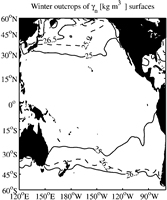
Figure 1. Winter (Jan–Mar in the north and Jul–Sep in the south)
surface outcrops of  n =
25.0 and 26.5 kg m
n =
25.0 and 26.5 kg m and the pycnocline
base (dashed lines) from seasonal climatologies of temperature (Levitus
and Boyer 1994) and salinity (Levitus
et al. 1994).
and the pycnocline
base (dashed lines) from seasonal climatologies of temperature (Levitus
and Boyer 1994) and salinity (Levitus
et al. 1994).
The  n = 25.0 kg m
n = 25.0 kg m surface has a specific volume anomaly of 301 (± 2) × 10
surface has a specific volume anomaly of 301 (± 2) × 10 m
m kg
kg and a potential density anomaly of 24.984 (± 0.004) kg m
and a potential density anomaly of 24.984 (± 0.004) kg m ,
very close to the second lightest surface of Tsuchiya
(1968). The Northern and Southern Hemisphere patterns differ largely. Depth
(Fig. 2a) shoals from over 225 m in the northwest
part of the region to less than 25 m off South America. A nearly zonal ridge
starts at 7°N off the western boundary, reaches 11°N by 125°W,
and terminates at its shallowest in the Costa Rica Dome (somewhat obscured in
this large-scale climatology) at 9°N, 90°W (Hoffman
et al. 1981). This ridge lies below the upwelling-favorable wind stress
associated with the ITCZ and separates the NEC and the NECC. A nearly zonal
trough starts at 3°N off the western boundary and reaches 5°N by 105°W.
East of 150°W, this trough separates the NECC to the north from the SEC
to the south. A ridge along the equator marks the dome associated with the upper
part of the EUC and separates the northern and southern branches of the SEC.
At the southern edge a marked eastward shoaling occurs about 120°W, with
isobaths fanning out equatorward and westward, a signature of the SEC. At least
some of the shoaling just off South America is owing to upwelling-favorable
alongshore winds there.
,
very close to the second lightest surface of Tsuchiya
(1968). The Northern and Southern Hemisphere patterns differ largely. Depth
(Fig. 2a) shoals from over 225 m in the northwest
part of the region to less than 25 m off South America. A nearly zonal ridge
starts at 7°N off the western boundary, reaches 11°N by 125°W,
and terminates at its shallowest in the Costa Rica Dome (somewhat obscured in
this large-scale climatology) at 9°N, 90°W (Hoffman
et al. 1981). This ridge lies below the upwelling-favorable wind stress
associated with the ITCZ and separates the NEC and the NECC. A nearly zonal
trough starts at 3°N off the western boundary and reaches 5°N by 105°W.
East of 150°W, this trough separates the NECC to the north from the SEC
to the south. A ridge along the equator marks the dome associated with the upper
part of the EUC and separates the northern and southern branches of the SEC.
At the southern edge a marked eastward shoaling occurs about 120°W, with
isobaths fanning out equatorward and westward, a signature of the SEC. At least
some of the shoaling just off South America is owing to upwelling-favorable
alongshore winds there.
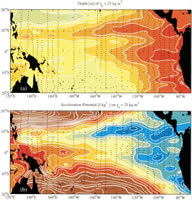
Figure 2a. Maps of properties on  n
= 25.0 kg m
n
= 25.0 kg m , within the tropical pycnocline.
Color palettes are consistent for Figs. 2–5 except for acceleration potential,
which has a varying offset. The locations of the mean hydrographic profiles
(black dots) are given by the average positions of the CTD stations within bins
mentioned in section 2. All panels are objectively mapped from values at these
locations. (a) Depth, contour intervals of 25 m. (b) Acceleration potential
relative to 900 dbar, contour intervals of 0.25 J kg
, within the tropical pycnocline.
Color palettes are consistent for Figs. 2–5 except for acceleration potential,
which has a varying offset. The locations of the mean hydrographic profiles
(black dots) are given by the average positions of the CTD stations within bins
mentioned in section 2. All panels are objectively mapped from values at these
locations. (a) Depth, contour intervals of 25 m. (b) Acceleration potential
relative to 900 dbar, contour intervals of 0.25 J kg .
.
Acceleration potential on this surface (Fig. 2b)
has a similar pattern to that of depth, but reversed in sign. A trough extends
from 6°N off the western boundary to 11°N, 125°W and terminates
around 9°N, 90°W. The eastward fall of values along this trough from
165°E to 135°W reveals interior flow southward from the NEC into the
NECC. Most of these isopleths can be traced northeast, originating off North
America. While the eastern part of this southward flow may be part of a tropical
recirculation centered at 11°N, 125°W, this pattern is weaker on lighter
neutral surfaces (not shown). A ridge on the equator with values falling between
the dateline and 105°W suggests equatorward pycnocline convergence feeding
the EUC. In the north, between the dateline and 150°W the NECC supplies
this convergence from the western boundary. From 150° to 100°W a ridge
at 3°–4°N separates the NECC from the SEC. Values falling eastward
along this ridge again indicate some southward interior flow from the NECC into
the SEC and subsequent convergence on the equator to feed the EUC. These southward
flows from the NEC to NECC starting at 165°E extending at most to 135°W
and from the NECC to the SEC from 150° to 100°W allow a somewhat convoluted
interior route for subtropical water from the northeast Pacific to reach the
EUC.
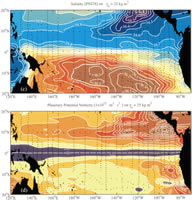
Figure 2b. (c) Salinity, contour intervals of 0.1 (PSS-78) . (d) Planetary
potential vorticity, contour intervals of 200 × 10 m
m s
s .
.
The Southern Hemisphere is simpler, lacking an ITCZ except in the west. Values
of acceleration potential (Fig. 2b) generally
fall equatorward and eastward to a trough at 3°–2°S from the date
line to about 100°W. This trough separates the SEC from the EUC. The falling
values all along this trough suggest a direct interior route for subtropical
water to reach the EUC from the southeast Pacific. However, west of the date
line a trough is evident at 6°S in the vicinity of the South Pacific convergence
zone, blocking the interior route to the equator. Eastward flow north of this
trough may be related to the South Equatorial Countercurrent (SECC). However,
this surface is too dense to fully reveal the SECC. In the west the SEC feeds
the New Guinea Coastal Undercurrent (Tsuchiya
et al. 1989).
Salinity on this surface (Fig. 2c) is relatively
high in the north-central Pacific, owing to a shallow salinity maximum of the
North Pacific tropical water (NPTW; Tsuchiya
et al. 1989) at  n =
24.3 kg m
n =
24.3 kg m . The NPTW is swept westward
and slightly southward in the NEC. The southeast Pacific is very salty, owing
to the strong South Pacific tropical water (SPTW) salinity maximum at
. The NPTW is swept westward
and slightly southward in the NEC. The southeast Pacific is very salty, owing
to the strong South Pacific tropical water (SPTW) salinity maximum at  n
= 24.6 kg m
n
= 24.6 kg m . The SPTW is swept westward
and equatorward in the SEC. In the northeast Pacific, fresher California Current
water (CCW; Tsuchiya
1968), with a salinity minimum at
. The SPTW is swept westward
and equatorward in the SEC. In the northeast Pacific, fresher California Current
water (CCW; Tsuchiya
1968), with a salinity minimum at  n
= 24.8 kg m
n
= 24.8 kg m , sweeps southward and westward
in the NEC, forming the relative minimum on this surface that separates the
NPTW and SPTW. In addition, the denser salinity minimum at
, sweeps southward and westward
in the NEC, forming the relative minimum on this surface that separates the
NPTW and SPTW. In addition, the denser salinity minimum at  n
= 26.7 kg m
n
= 26.7 kg m , a signature of the North
Pacific Intermediate Water (NPIW), may exert some influence, even at this shallow
surface, through diapycnal fluxes into the strong shallow pycnocline under the
ITCZ. Finally, freshness from excess rainfall under the ITCZ may also mix down
to this surface. The equatorial convergence (Fig.
2b) of these three fresh northern sources and the salty SPTW creates a strong
meridional salinity gradient at the equator. Slight northward penetration of
SPTW across the equator is evident near the western boundary. In addition, the
meridional salinity maximum at 1°S between 135° and 100°W is
owing to SPTW advected eastward in the EUC.
, a signature of the North
Pacific Intermediate Water (NPIW), may exert some influence, even at this shallow
surface, through diapycnal fluxes into the strong shallow pycnocline under the
ITCZ. Finally, freshness from excess rainfall under the ITCZ may also mix down
to this surface. The equatorial convergence (Fig.
2b) of these three fresh northern sources and the salty SPTW creates a strong
meridional salinity gradient at the equator. Slight northward penetration of
SPTW across the equator is evident near the western boundary. In addition, the
meridional salinity maximum at 1°S between 135° and 100°W is
owing to SPTW advected eastward in the EUC.
The planetary component of potential vorticity on this surface (Fig.
2d) also exhibits contrasting patterns in the Northern and Southern Hemispheres.
At the northern edge low potential vorticity, especially from 160°W to
125°W, is the remnant of eastern STMW (discussed below) formed to the north.
Under the ITCZ values peak at 10°N, 125°W and again at 11°N,
95°W. This peak under the ITCZ is where the pycnocline is drawn closest
to the surface by Ekman pumping associated with the large-scale wind stress
curl and strengthened, perhaps by some combination of mixing and surface buoyancy
flux. The pattern there is striking because acceleration potential contours
(Fig. 2b) parallel isovorts (Fig.
2d), showing how the southward flow from the NEC to the NECC does not cross
the high potential vorticity under the ITCZ, but moves around it. In the Southern
Hemisphere, where the sign of potential vorticity is reversed, the only high
magnitudes are off South America, where the pycnocline shoals and strengthens.
Elsewhere, potential vorticity is low and relatively uniform. This pattern is
associated with eastern STMW that has a vertical minimum around  n
= 25.3 kg m
n
= 25.3 kg m , visible in vertical sections.
This minimum is strongest at the southern boundary around 120°W where the
surface shoals rapidly from west to east (Fig. 2a).
The uniformity of potential vorticity in the Southern Hemisphere shows there
is no impediment to direct interior convergence of water from the subtropics
to the equator in the SEC. Finally, isovorts around the equator are spread in
the west and pinched in the east, a pattern consistent with acceleration potential
and salinity distributions that suggest equatorward interior pycnocline convergence
feeding the EUC.
, visible in vertical sections.
This minimum is strongest at the southern boundary around 120°W where the
surface shoals rapidly from west to east (Fig. 2a).
The uniformity of potential vorticity in the Southern Hemisphere shows there
is no impediment to direct interior convergence of water from the subtropics
to the equator in the SEC. Finally, isovorts around the equator are spread in
the west and pinched in the east, a pattern consistent with acceleration potential
and salinity distributions that suggest equatorward interior pycnocline convergence
feeding the EUC.
The  n = 26.5 kg m
n = 26.5 kg m surface has a specific volume anomaly of 165 (±2) × 10
surface has a specific volume anomaly of 165 (±2) × 10 m
m kg
kg and a potential density anomaly of 26.438 (±0.006) kg m
and a potential density anomaly of 26.438 (±0.006) kg m ,
close to the densest surface described by Tsuchiya
(1968). The fields for this surface are markedly different from those within
the pycnocline. Poleward and westward the depth of this surface (Fig.
3a) exceeds 500 m in the NEC and 425 m in the SEC. A ridge under the ITCZ
starts at 6°N off the western boundary, peaks at less than 150 m at 10°N,
135°W, and extends eastward to 7°N, 100°W. In the Southern Hemisphere,
a similar ridge starts at 3°S off the western boundary and turns at 150°W
to reach 15°S off South America. It is shallowest near 9°S, 95°W.
An equatorial trough, from bowing at the base of the EUC, deepens toward both
boundaries.
,
close to the densest surface described by Tsuchiya
(1968). The fields for this surface are markedly different from those within
the pycnocline. Poleward and westward the depth of this surface (Fig.
3a) exceeds 500 m in the NEC and 425 m in the SEC. A ridge under the ITCZ
starts at 6°N off the western boundary, peaks at less than 150 m at 10°N,
135°W, and extends eastward to 7°N, 100°W. In the Southern Hemisphere,
a similar ridge starts at 3°S off the western boundary and turns at 150°W
to reach 15°S off South America. It is shallowest near 9°S, 95°W.
An equatorial trough, from bowing at the base of the EUC, deepens toward both
boundaries.
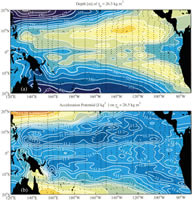
Figure 3a. Maps of properties on  n
= 26.5 kg m
n
= 26.5 kg m , below the tropical pycnocline.
Details follow Fig. 2. (a) Depth, contour intervals of 25 m. (b) Acceleration
potential relative to 900 dbar, contour intervals varying from 0.1 to 0.25 J
kg
, below the tropical pycnocline.
Details follow Fig. 2. (a) Depth, contour intervals of 25 m. (b) Acceleration
potential relative to 900 dbar, contour intervals varying from 0.1 to 0.25 J
kg .
.
Acceleration potential (Fig. 3b) again has
some inverse correlation with depth. A nearly zonal trough starts at 5°N
off the western boundary and reaches 6°N by 100°W. This trough delineates
a cyclonic gyre with a narrow, rapid equatorward limb (the NSCC) and a wider,
slower poleward limb starting at 20°N, 120°W and reaching 10°N
by the western boundary (the deep NEC). These limbs are clearly connected by
southward flow in the west and northward flow in the east. In the south, an
analogous, but more tenuous gyre defined by the 11.5 J kg contour starts at 5°S in the west and reaches 15°S just off South
America. The SSCC forms the equatorward limb and the deep SEC the poleward limb.
The poleward flow connecting these currents in the east probably occurs so close
to the continent that it is not resolved by the climatology, although diapycnal
mixing may also play a role in the mass balance near the eastern boundary. Acceleration
potential does not reveal flow at very low latitudes, but direct velocity measurements
there suggest some westward return flow equatorward of the SCCs, implying deep
anticyclonic gyres (Rowe
et al. 2000). Notably, all these gyres effectively isolate the equator from
deep interior subtropical ventilation.
contour starts at 5°S in the west and reaches 15°S just off South
America. The SSCC forms the equatorward limb and the deep SEC the poleward limb.
The poleward flow connecting these currents in the east probably occurs so close
to the continent that it is not resolved by the climatology, although diapycnal
mixing may also play a role in the mass balance near the eastern boundary. Acceleration
potential does not reveal flow at very low latitudes, but direct velocity measurements
there suggest some westward return flow equatorward of the SCCs, implying deep
anticyclonic gyres (Rowe
et al. 2000). Notably, all these gyres effectively isolate the equator from
deep interior subtropical ventilation.
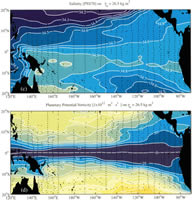
Figure 3b. (c) Salinity, contour intervals of 0.1 (PSS-78). (d) Planetary
potential vorticity, contour intervals of 25 × 10 m
m s
s .
.
This surface is fresh at the northern edge, owing to the combined influence
of lighter CCW to the east and denser NPIW to the west (Fig.
3c). In the southeast the fresh influence of Antarctic Intermediate Water
(AAIW), a vertical salinity minimum at  n
= 27.2 kg m
n
= 27.2 kg m , is evident. Higher Coral
Sea and equatorial values encompassed by the 34.8 isohaline are owing to the
mixing of salt from above. The meridional maximum starting at 4°S off the
western boundary and reaching 7°S off South America is consistent with
eastward advection in the SSCC. The salinity front at 2°N off the western
boundary, reaching 4.5°N by 105°W (Fig.
3c), suggests that there is little meridional flow across the NSCC (Gouriou
and Toole 1993). Similarly, another front starting at 10°N off the
western boundary and reaching 20°N by 110°W suggests that meridional
flow is also small at the northern limb of the deep gyre. The relatively homogenous
region between these fronts, with slightly fresher subtropical waters advected
eastward in the equatorward limb of the gyre and slightly saltier equatorial
waters advected westward in the northern limb, is consistent with a tracer swirling
around the gyre edge and homogenizing in the gyre interior.
, is evident. Higher Coral
Sea and equatorial values encompassed by the 34.8 isohaline are owing to the
mixing of salt from above. The meridional maximum starting at 4°S off the
western boundary and reaching 7°S off South America is consistent with
eastward advection in the SSCC. The salinity front at 2°N off the western
boundary, reaching 4.5°N by 105°W (Fig.
3c), suggests that there is little meridional flow across the NSCC (Gouriou
and Toole 1993). Similarly, another front starting at 10°N off the
western boundary and reaching 20°N by 110°W suggests that meridional
flow is also small at the northern limb of the deep gyre. The relatively homogenous
region between these fronts, with slightly fresher subtropical waters advected
eastward in the equatorward limb of the gyre and slightly saltier equatorial
waters advected westward in the northern limb, is consistent with a tracer swirling
around the gyre edge and homogenizing in the gyre interior.
Potential vorticity on this surface (Fig. 3d)
increases nearly monotonically in magnitude poleward. However, lower values
in the east are associated with the thickening equatorial pycnostad. In the
Southern Hemisphere, a strong meridional front separating the equatorial pycnostad
from the subtropical waters is evident, starting at 3°S off the western
boundary and reaching 15°S off South America. This front runs along the
SSCC, suggesting an absence of meridional exchange across this current. In the
Northern Hemisphere, a similar front starts at 2°N off the western boundary
and extends to about 5°N, 105°W. As in the salinity field, there is
another front associated with the northern limb of this deep cyclonic gyre starting
at 20°N, 110°W and reaching 10°N off the western boundary. Also
paralleling the salinity field, between these fronts there is a relatively homogenous
region where high subtropical values are advected eastward in the NSCC and low
tropical values are swept northward in the eastern Pacific and then westward
in the deep NEC. The low values under the ITCZ and off the South American coast
suggest that upwelling-driven vortex stretching below the pycnocline is associated
with the poleward transport in the deep cyclonic gyres.
In summary, property maps on two neutral surfaces highlight differences between
the two hemispheres within the tropical pycnocline as well as changes at the
pycnocline base. The pycnocline shoals from west to east, and under the ITCZ.
In the north, equatorward flow of relatively fresh pycnocline water follows
a serpentine route to skirt westward of the eastern potential vorticity maximum
under the ITCZ. In the south, relatively salty pycnocline water follows a much
more direct interior route to the equator through a region of homogenous and
low potential vorticity characteristic of strong eastern STMW there. Below the
pycnocline, deep cyclonic gyres are evident in each hemisphere, precluding any
interior equatorward flow there. Acceleration potential, salinity, and potential
vorticity distributions are consistent with advection around these deep gyres,
and homogenization within them, especially in the northern hemisphere.
Return to previous section or go to next
section
PMEL Outstanding Papers
PMEL Publications Search
PMEL Homepage
 n = 25.0 kg m
n = 25.0 kg m ,
is chosen for proximity to the equatorial pycnocline, the EUC, and the subtropical
mode water (STMW) vertical potential vorticity minima (best seen in the meridional-vertical
sections discussed below). The denser surface,
,
is chosen for proximity to the equatorial pycnocline, the EUC, and the subtropical
mode water (STMW) vertical potential vorticity minima (best seen in the meridional-vertical
sections discussed below). The denser surface,  n
= 26.5 kg m
n
= 26.5 kg m , is chosen to lie below the
pycnocline, but within the equatorial pycnostad and the SCCs. Winter outcropping
locations of the lighter surface are in the subtropics and the denser surface
in the subpolar regions (Fig. 1). Depth locates
the neutral surface and its gradients give a sense of vertical geostrophic shear.
Acceleration potential contours are streamlines of geostrophic velocity on that
surface relative to 900 dbar. Salinity on a neutral surface is a passive tracer
inversely related to temperature since saltier water must be cooler and fresher
water must be warmer to remain on the neutral surface. Finally, the planetary
component of the potential vorticity is a dynamically active tracer that (away
from the equator and the western boundary) has seldom been described in the
Tropics, but see Gouriou
and Toole (1993) . In the absence of mixing and boundary forcing, both salinity
and potential vorticity are conservative on neutral surfaces. However, in the
ocean, these properties are not strictly conserved. Their distribution on neutral
surfaces is governed by both advection and diffusion.
, is chosen to lie below the
pycnocline, but within the equatorial pycnostad and the SCCs. Winter outcropping
locations of the lighter surface are in the subtropics and the denser surface
in the subpolar regions (Fig. 1). Depth locates
the neutral surface and its gradients give a sense of vertical geostrophic shear.
Acceleration potential contours are streamlines of geostrophic velocity on that
surface relative to 900 dbar. Salinity on a neutral surface is a passive tracer
inversely related to temperature since saltier water must be cooler and fresher
water must be warmer to remain on the neutral surface. Finally, the planetary
component of the potential vorticity is a dynamically active tracer that (away
from the equator and the western boundary) has seldom been described in the
Tropics, but see Gouriou
and Toole (1993) . In the absence of mixing and boundary forcing, both salinity
and potential vorticity are conservative on neutral surfaces. However, in the
ocean, these properties are not strictly conserved. Their distribution on neutral
surfaces is governed by both advection and diffusion. 
 m
m and a potential density anomaly of 24.984 (± 0.004) kg m
and a potential density anomaly of 24.984 (± 0.004) kg m

 m
m
